NCERT Solutions for Class 10 Science Chapter 6 Life Processes Important Questions
Here are the important questions for CBSE Class 10 Science Chapter 6 Life Processes. The important questions we have compiled will help the students to brush up on their knowledge about the subject. Students can practice Class 10 Science important questions to understand the subject better and improve their performance in the board exam. The solutions provided here will also give students an idea about how to write the answers. Take Free Online MCQ Test for Class 10
Important Question for CBSE Class 10 Science Chapter 6 Life Processes
Video of Life Processes Important Questions
Class 10 Science Life Processes MCQs (1 Marks)
Q. In amoeba, food is digested in the:
(a) Food vacuole
(b) Mitochondria
(c) Pseudopodia
(d) Chloroplast
Answer – (a)
Q. Which of the following events in the mouth cavity will be affected if salivary amylase is lacking in the saliva?
(a) Starch breaking down into sugars.
(b) Proteins breaking down into amino acids.
(c) Absorption of vitamins.
(d) Fats breaking down into fatty acids and glycerol.
Answer – (a)
Q. What are the products obtained by anaerobic respiration in plants?
(a) Lactic acid + Energy
(b) Carbon dioxide + Water + Energy
(c) Ethanol + Carbon dioxide + Energy
(d) Pyruvate
Answer – (c)
Q. Name the substances whose build up in the muscles during vigorous physical exercise may cause cramps?
(a) Ethanol + Carbon dioxide + Energy
(b) Lactic acid + Energy
(c) Carbon dioxide + Water + Energy
(d) Pyruvate
Answer – (b)
See Video of Life Processes Important Questions
Q. Which plant tissue transports water and min-erals from the roots to the leaf?
(a) Xylem
(b) Phloem
(c) Parenchyma
(d) Collenchyma
Answer – (a) Xylem
Q. Which part of nephron allows the selective reabsorption of useful substances like glucose, amino acids, salts and water into the blood capillaries?
(a) Tubule
(b) Glomerulus
(c) Bowman’s capsule
(d) Ureter
Answer – (a)
Class 10 Science Life ProcessesShort Answer Type 1
Q. Why do herbivores have longer, small intestines than carnivores?
Answer – The length of the small intestine differs in various animals depending on the type of food they eat. Cellulose is a carbohydrate food which is digested with difficulty. So the herbivorous animals like cows which eat grass need a longer small intestine to allow the cellulose present in grass to be digested completely.
Q. (i) Name two waste products which are stored in old xylem in plants.
(ii ) Name the process by which plants get rid of excess water. Name the pores through which this process takes place.
Answer – (i) Resin and gums are the two wastes which are stored in old xylem in plants.
(ii) Transpiration is the process by which plants get rid of excess water. Stomatal pores are the pores through which transpiration takes place.
Q. Name the type of asexual reproduction in which two individuals are formed from a single parent and the parental identity is lost.
Write the first step from where such a type of reproduction begins.
Draw the first two stages of this reproduction.
Answer – The type of asexual reproduction in which two individuals are formed from a single parent and parental identity is lost is called Binary fission.
The first step of this reproduction is elongation of cells and its nucleus.
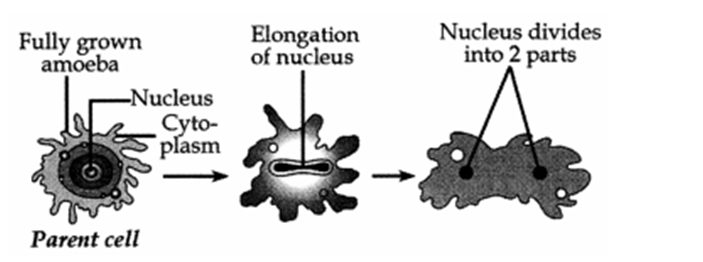
Class 10 Science Life Processes Short Answer Type II
Q. Name three different glands associated with the digestive system in humans. Also name their secretions.
Answer – Three glands associated with the digestive system are as follows:
1. Salivary glands in the mouth produce saliva. Saliva contains an enzyme called salivary amylase which digests the starch present in food into sugar.
2. Liver is the largest gland which secretes bile and pours its secretion in the duodenum (part of the small intestine). Bile makes the acidic food coming from the stomach alkaline so that pancreatic enzymes can act on it. Bile salts also break the fats present in the food into small globules.
3. Pancreas is also a large gland that secretes pancreatic juice into the duodenum. Pancreatic juice contains pancreatic amylase which breaks down the starch.
Trypsin digests the protein.
Lipase which breaks down the emulsified fats.
Pancreatic juice acts on an alkaline medium.
Q. (a) What is translocation? Why is it essential for plants?
(b) Where are the substances translocated by the phloem delivered?
Answer – (a) The movement of food from leaves to other parts of the plant in phloem is called translocation. The translocation is necessary because every part of the plant needs food for obtaining energy, for building its parts and maintaining its life.
(b) The movement of food in the phloem is transported upwards or downwards depending on the needs of the plant, for example, in spring, even the sugar stored in the root or stem tissue of a plant would be transported through phloem to the buds which need energy to grow.
Q. (i) Which organ secretes a hormone when the blood sugar rises? Name a digestive enzyme released by this organ.
(ii) Why pancreas helps in digestion and also regulates blood sugar?
Answer – (i) Pancreas secretes insulin (hormone) when the blood sugar rises. Pancreas secretes pancreatic juice which contains digestive enzymes.
(ii) Pancreas secretes enzymes like pancreatic amylase which breaks down starch, trypsin which breaks down proteins and lipase breaks down emulsified fats. Pancreas also secretes a hormone called insulin which controls the metabolism of sugar. Therefore it lowers the blood sugar level. So the pancreas is both an exocrine and an endocrine gland.
Q. Give reasons for the following:
(a) Arteries are thick-walled.
(b) Blood goes only once through the heart in fishes.
(c) Plants have low energy needs.
Answer – (a) Arteries have thick walls because these vessels carry blood from the heart to all the parts of the body and blood emerges from the heart under high pressure.
(b) A fish has a two-chambered heart and has gills to oxygenate blood. In a fish, the heart pumps deoxygenated blood to gills where oxygenation of blood takes place. The oxygenated blood from the gills is supplied to the body parts of the fish where oxygen is utilized and carbon dioxide enters into it, making it deoxygenated.
This deoxygenated blood returns to the heart to be pumped into gills again. Thus blood passes through the heart of fish only once in one complete cycle.
(c) Plants are fixed at a place and do not show any locomotion. Plants are less active. Their cells do not need to be supplied with materials so quickly. Therefore plants have low energy needs and respire at a slow rate.
Q. Draw a neat diagram of the excretory system of human beings and label on it:
Kidney, Urinary bladder, Ureter
Answer – Excretory System:
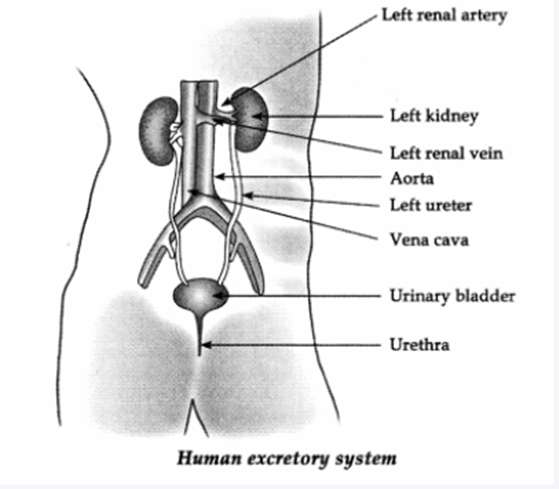
Q. Name any three glands associated with digestion in humans. Write the names of enzymes secreted by them.
Answer –
|
Glands |
Enzymes |
|
1. Salivary glands |
|
|
2. Pancreas |
|
|
3. Gastric glands |
|
Q. Bile juice does not contain any enzyme but bile salts are important for digestion and absorption of fats. State reason.
Answer
Bile is a digestive juice secreted by the liver. Although it does not contain any digestive enzymes, it plays an important role in the digestion of fats.
Bile is alkaline and contains salts which help to emulsify or break the fats (or lipids) present in the food. Thus, bile performs two functions:
Makes the acidic food coming from the stomach alkaline so that pancreatic enzymes can act on it. Bile salts break the fats present in the food into small globules making it easy for the enzymes to act and digest them.
Q. (a) State reason for the following:
(i) Rings of cartilage are present in the trachea.
(ii) Plants look green in colour.
(b) Write other names of the following:
(i) Alveolar sac
(ii) Voice box
Answer –
(a) (i) The air coming from the nostrils during breathing passes through the trachea. The trachea does not collapse even when there is no air in it because it is supported by rings of soft cartilages.
(ii) Plants look green in colour because of the presence of a green pigment called chlorophyll in their chloroplasts.
(b) (i) Alveolar sac → Alveoli
(ii) Voice box → Larynx
Q. Describe the structure and functioning of nephrons.
Answer –
Structure of nephron. Nephron is the basic filtration unit in the kidney. It consists of a tubule which is connected with a collecting duct at one end and a cup shaped structure at the other end, called Bowman’s capsule. Every Bowman’s capsule contains a cluster of capillaries called glomerulus within the cup-shaped structure. The blood enters into glomerulus through afferent arteriole of renal artery and leaves it through different arterioles.
Basic functions of Nephrons
Filtration: Filtration of the blood takes place in Bowman’s capsule in the capillaries of the glomerulus. Then this filtrate passes into the tubular part of the nephron. The filtrate contains glucose, amino acids, urea and uric acid and a large amount of water.
Reabsorption: The filtrate flows along the tubule and useful substances such as glucose, amino acids, salts and some water are re-absorbed into the blood by the capillaries surrounding the nephron tubule.
Urine: The filtrate which remains after the re-absorption is called the urine, which is collected from nephron by the collecting duct to carry it to the urinary bladder and then to the urethra
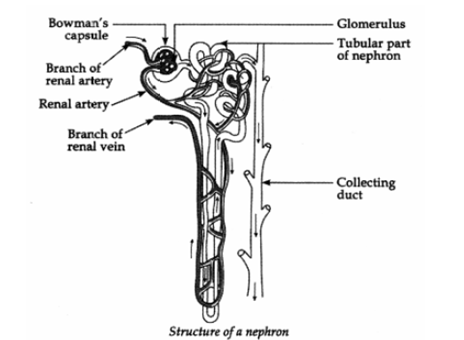
Q. Draw a labelled diagram of the human heart.
Answer –

Important Videos Links
Class 10 Science Life Processes Long Answer Type
Q. Draw the diagram of sectional view of human heart and on it name and label the following parts:
(a) The chamber of the heart that pumps out deoxygenated blood.
(b) The blood vessel that carries away oxygenated blood from the heart.
(c) The blood vessel that receives deoxygenated blood from the lower part of our body.
Answer –
(a) The chamber of the heart that pumps out deoxygenated blood – Right ventricle
(b) The blood vessel that carries away oxygenated blood from the heart – Aorta
(c) The blood vessel that receives deoxygenated blood from the lower part of our body – Inferior Vena Cava
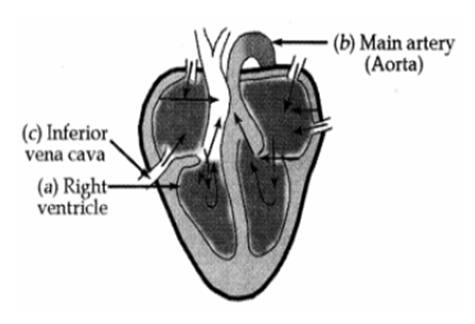
Q. (a) Draw a diagram of human alimentary canal and label the following parts:
(i) Largest gland.
(ii) Gland that secretes digestive enzymes and hormone.
(iii) Part where HCl is produced.
(iv) Part where digested food is absorbed.
(b) What are villi? Explain their function in the digestive system.
Answer –
(a)(i) Largest gland – Liver
(ii) Gland that secretes digestive enzymes and
hormone – Pancreas
(iii) Part where HCl is produced – Stomach
(iv) Part where digested food is absorbed – Small intestine
(b) The small intestine is especially adapted for absorption of digested food.
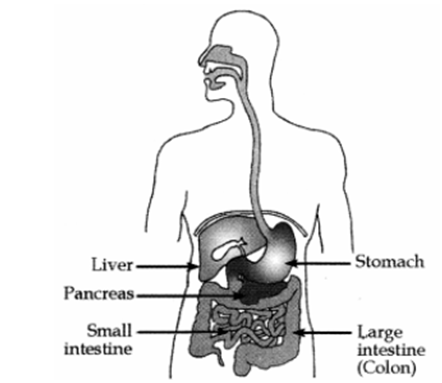
Q. (a) Draw a diagram of human alimentary canal and label the following parts:
(i) Largest gland.
(ii) Gland that secretes digestive enzymes and hormone.
(iii) Part where HCl is produced.
(iv) Part where digested food is absorbed.
(b) What are villi? Explain their function in the digestive system.
Answer –
(a)(i) Largest gland – Liver
(ii) Gland that secretes digestive enzymes and
hormone – Pancreas
(iii) Part where HCl is produced – Stomach
(iv) Part where digested food is absorbed – Small intestine
(b) The small intestine is especially adapted for absorption of digested food.

Q. Draw the human respiratory system and label the following parts:
(a) Trachea
(b) Alveoli
(c) Respiratory bronchioles
(d) Larynx
Describe in brief the role of lungs in the exchange of gases.
Answer –
Human Respiratory System
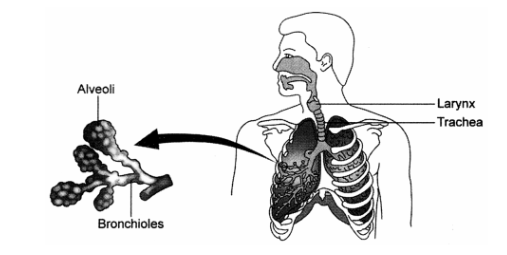
Role of Lungs
1. When we breathe in air, the diaphragm contracts which results in the increase of chest cavity. Due to this expansion of chest cavity, the air pressure in the lungs decreases. Thus, air from outside rushes into the lungs through nostrils, trachea and bronchi. Thus sacs of lungs get filled with air when we breathe in. The exchange of gases between alveoli and blood takes place by the process of diffusion.
2. Now the air present in air sacs of the lungs is rich in CO2. When we breathe out air, the diaphragm relaxes which results in the decrease of chest cavity. This contraction pushes the air from the lungs into the trachea, nostrils and then out of the body into air. Breathing in of air is called inhalation and breathing out of air is called exhalation.
Important Questions Videos Links